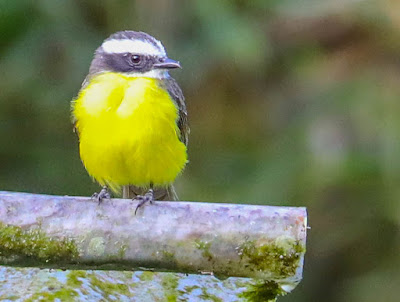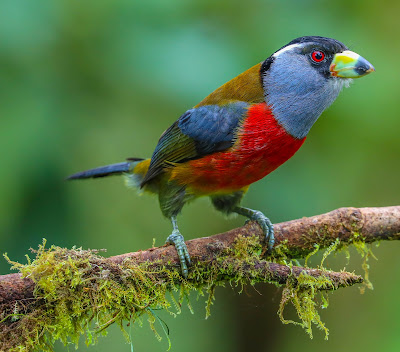Mashpi Amagusa Reserve is 320 acres of private land in the Mashpi-Pachijal Important Bird Area owned and operated by Sergio and Doris Basantes. It is an area of high biodiversity with many Choco-endemic birds.
Choco refers to a strip of cloud forest, beginning at about 1,200 feet of elevation, flanked by the Pacific Ocean on the west, to about 7,200 feet, with the Andean Mountain range to the east, from Ecuador up into Colombia. The ocean brings humid winds ashore and the mountains keep the rain clouds locked in the area. It creates a tropical habitat that is dense and diverse. This habitat, isolated by mountains, has developed a unique variety of wildlife, different from the wildlife of the Amazon rainforests on the other side of the Andes. The diversity is particularly high among birds. The term
Choco comes from the Colombian state Choco and originally referred to the lowland rainforest on the coast of Colombia. Now it has expanded to refer to the cloud forest of a larger area described above.
.png) |
| Map showing relationship of Mashpi Amagusa Reserve to Mindo and the Mashpi Lodge. Photo from here. |
 |
| This photo of the Mashpi Lodge is taken from here. It is in the heart of the Ecuadorian cloud forest and the lodge is bathed in light. The Mashpi Amagusa Reserve is up the same hill near the top. |
At least from what I experienced (I did not explore much of the 320 acres), there was one birding area with a large tree, near the Basante house, where big bunches of whole bananas were tacked to a tree. This attracted the rose-cheeked parrots we saw. A short distance away there were several types of hummingbird feeders in an open area with a little overhang nearby, to provide shade or protection from rain. This was where we saw 11 species of hummingbird. Then there was a dirt trail a short distance up a small hill to an area surrounded by tall trees and a small stand of crossing tree limbs covered with moss to which halved bananas were attached to nails. Right behind it was another covered shelter and some seats. This is the area where we saw most of the other birds. We did take a walk down the dirt road to the Mashpi Lodge gate, about a quarter mile, where we saw some additional birds. I believe this road was also part of or right next to the Amagusa Reserve. The Amagusa Reserve is known for a variety of Choco endemic species, including the following 13 species that we saw: 6 hummingbirds, including the empress brilliant, velvet-purple coronet, violet-tailed sylph, brown Inca, purple-bibbed whitetip and white-whiskered hermit; 4 tanagers, including the glistening-green tanager, black-chinned mountain tanager, moss-backed tanager and rufous-throated tanager; and 3 other birds, including the rose-faced parrot, toucan barbet, and orange-breasted fruiteater.
Following are some photos of the birds I saw:
 |
| This is the single best place to see the very local moss-backed tanager within its very small range. |
 |
| Orange-bellied euphonia |
 |
| Orange-billed sparrow |
 |
| Ornate flycatcher |
 |
| Purple-bibbed whitetip (hummingbird) |
 |
| Purple-throated woodstar (hummingbird) |
 |
| Rose-faced parrot |
 |
| Rufous-throated tanager |
 |
| Rusty-margined flycatcher |
 |
| Slate-throated redstart |
 |
| Smoke-colored peewee |
 |
| Toucan barbet |
 |
| Velvet purple coronet (hummingbird) |
 |
| Violet-tailed sylph - male (hummingbird) |
 |
| Violet-tailed sylph - female |
 |
| Wedge-billed woodcreeper |
 |
| White-whiskered hermit (hummingbird) |
.png)














































What an INCREDIBLE assortment! The showiest has to be the toucan barbet, but maybe my favorite is the juvenile flame-rumped tanager, which looks like it has the bird version of acne.
ReplyDelete